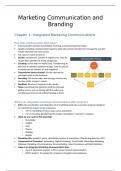Marketing Communication and
Branding
Chapter 1: Integrated Marketing Communications
How does communication take place?
Communication involves transmitting, receiving, and processing information
Quality marketing communication happens when the receiver decodes the message the way the
sender intended it to come across.
Say a person wants to dine in:
Sender: includes KFC, Chick-fil-A, Popeyes etc. They try
to gain their attention by hiring ad agencies
Encoding: verbal and non-verbal cues. Transforming an
idea into an attention-getting message. Cues are placed
in media such as Internet, tv, and magazines
Transmission device/channel: Via the internet the
message travels to the audience
Decoding: This occurs when the message reaches one
or more of the receiver’s senses.
Feedback: Receiver’s response to the sender
Noise: Everything that interferes with the message
getting across, such as driving with the radio on or
scrolling past internet ads without looking at them.
What is an integrated marketing communications (IMC) program?
IMC is the coordination and integration of all marketing tools into a seamless program designed
to maximize the impact on the customers.
o 4 P’s in marketing: Product, place, price, promotion
o 3 C’s in branding (positioning the brand): Competitors, customers, company
What do you need for IMC planning?
o Knowledge
o Insights
o Data
o Theory
o Strategy
o Results
Marketing Mix: products, prices, distribution systems & promotions (The starting point for IMC)
Components of Promotion: Advertising, Digital Marketing, Social Media, Alternative Marketing,
Database Marketing, Direct Response, Personal Selling, Sales Promotions and Public Relations
Steps of an Integrated Marketing Communications Plan:
o Current situational Analysis: A firm's present market representation
o SWOT Analysis: To analyze the company’s strengths and weaknesses
, o Marketing objectives: These are assigned to key target markets (e.g. higher sales)
o Target market
o Marketing Strategies and Tactics: The strategies include all positioning, differentiation,
and branding strategies. The tactics are the activities to support the strategies
o Implementation: How to implement the plan
o Evaluation of performance: Specifying methods to evaluate the performance
Which trends are affecting marketing communications?
Emphasis on Accountability and measurable results: Companies are not willing to pump their
money into TV commercials for minimal results. They replace it with digital, social, and
alternative communication ads.
Mobile Marketing: TV commercials are replaced by funds for digital marketing and Social Media.
These digital channels provide customers with access to lots of info about companies, products,
and brands -> Mobile marketing is a mandatory ingredient rather than an option
Integration of Media Platforms: People spend more than 10 hours in front of a screen including
mobile phones and TV
o Content Grazing: Looking at 2 or more screens at the same time to gather different types
of content
o Investigative Spider-Webbing: When a person investigates specific content by looking on
multiple platforms (watching a game and looking stats up online
o Quantum Journey: Focusing on a specific task
o Social Spider-webbing: When consumers share content or info across multiple devices
Changes in Channel Power: Consumers' relations with brands have shifted, since consumers have
the power of channels now, by looking up reviews. The same principles apply to business-to-
business activities
Increases in Global Competition: Consumers desire convenience and quality for a low price, and
the distance doesn’t matter, because of delivery systems
Increases in Brand Parity: Consumers select an item from different brands, and quality becomes
less of a concern -> decline in brand loyalty
Emphasis on Customer Engagement: brands try to reach customers at every contact point by
using two-way communication. The brand delivers incentives for consumers to connect with their
brand, and the consumers need to develop emotional connections to the brand and then the
brand delivers promises and reasons for consumers to continue interacting with their brand.
Focus on Convenience: Consumers value time in new and important ways
Cause-related Marketing and Advertising: There is a rise in interest in buying products that are
connected to a cause or socially responsible efforts.
Five reasons why IMC works:
o Unifies strategy and message across channels
o Streamlines timing
o Connects with multiple audiences
o Creates meaningful insights
o Maximises impact
, What are the components of an integrated marketing communications program?
What is meant by GIMC?
GIMC are globally integrated marketing communication programs
It is bigger than IMC but the objectives are the same, however, GIMC operates on a global level
o Standardization: Creating a global product using a more universal promotional theme
o Adaptation: The creation of products and marketing messages designed for and adapted
to individual countries






